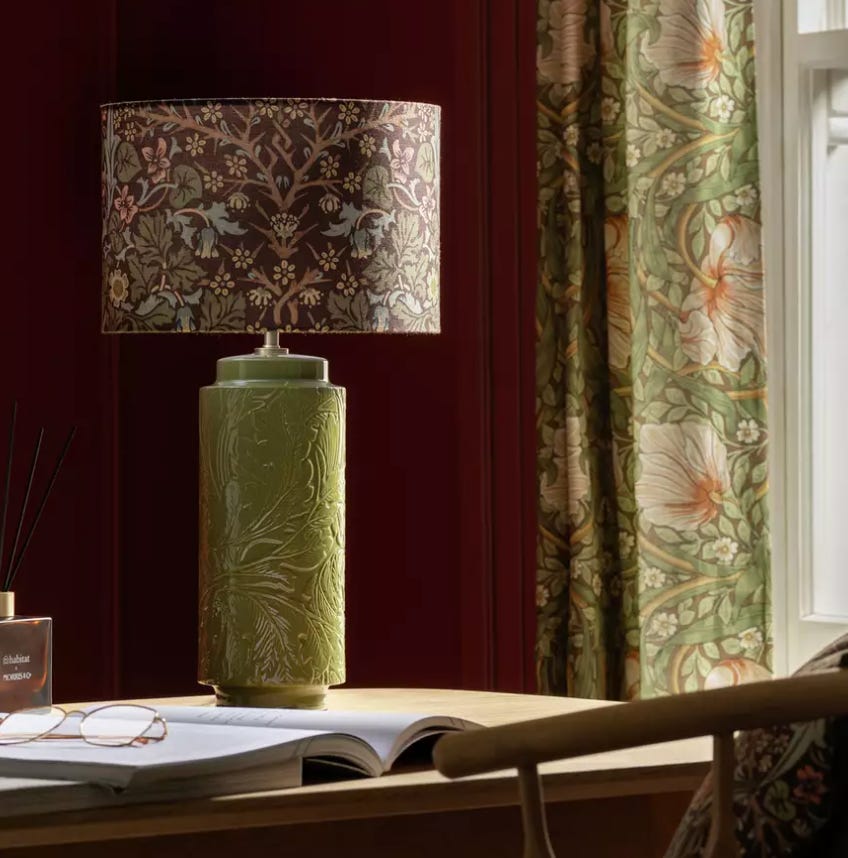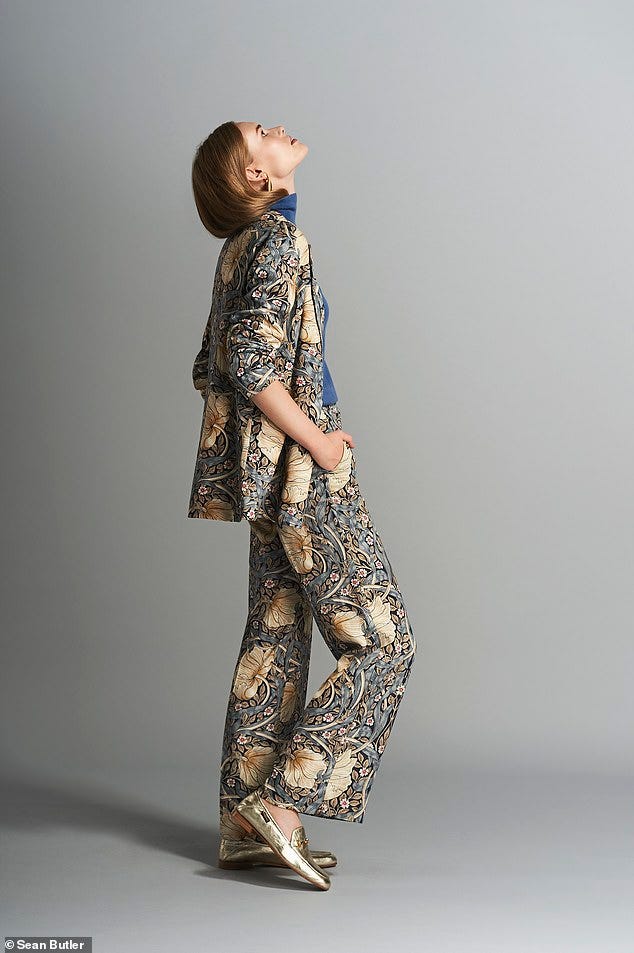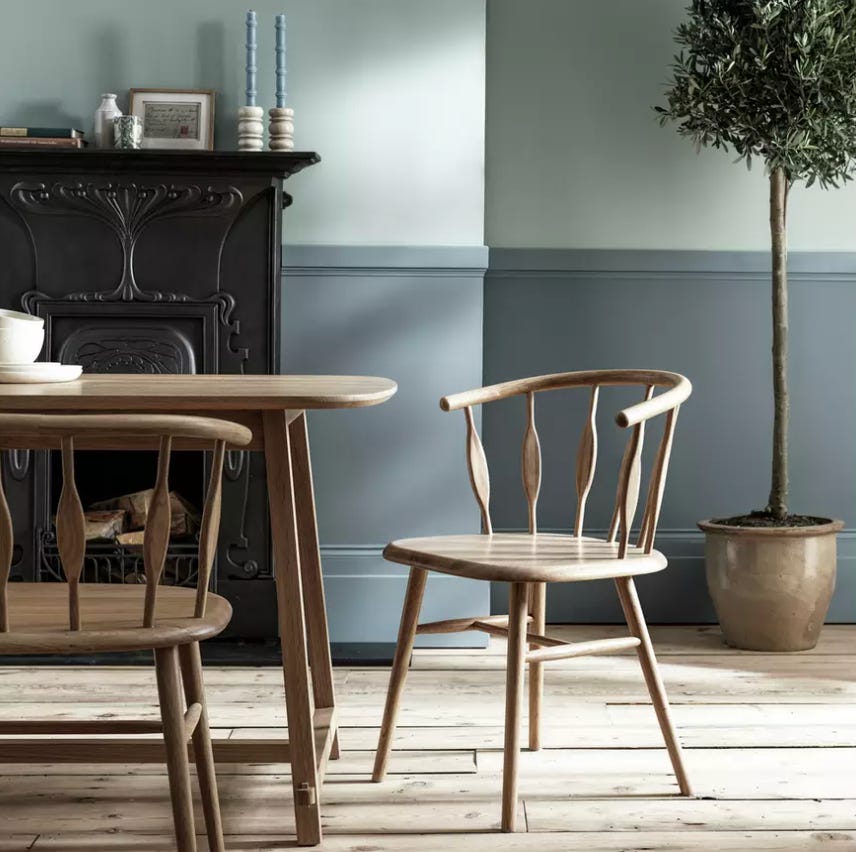Design Postcards: William Morris
A short (free) post. Why everyone wants a piece of the Victorian master. And why we need to stop now.
William Morris died in 1896, leaving behind at least 93 wallpaper designs and 143 fabrics, created either by himself or the designers that worked under him. That’s already quite a legacy. But once a creator has been dead for 75 years, their work is deemed to be out of copyright – so anyone (and frequently everyone) can reproduce the work on their own merchandise.
In short, and I’ll do the sums for you, brands have been using his designs since 1971. That’s already a lot. Then, in March this year, The Sanderson Design Group, which owns the original Morris archive, struck a worldwide deal to expand still further the availability of products featuring his designs in a new e-commerce venture. It is, says the press release which landed in my inbox last week, “primarily to enlighten global customers on the rich history of William Morris designs” by selling “ready made homeware, curtains, headboards, cushions, blinds, fabric, wallpaper, and paint.” The point being that while they can’t stop the third-party copies, they can try and encourage you to buy “more valued and elevated” pieces created using the traditional techniques and original patterns. I couldn’t help but wonder (as the voiceover goes): Is the horse already bolting down the street, wearing a Morris & Co blanket?
You can buy a Strawberry Thief oven glove from Dunelm, a pair of socks from Corgi, or a tea set from M&S. You can buy soap, hand cream, ties, pyjamas, lampshades and dog beds, not to mention rugs - brilliantly reinterpreted by House of Hackney and washable from Ruggable. You can buy Morris designs on bedding in every high-street store and many outlets. Exclusive it ain’t.

What would the champion of handmade production, who fought against the Victorian era’s focus on industrial progress think? Of course, he was a contradiction himself; a man who inherited enough money not to need to work, he also believed passionately that everyone should have access to good design: “Have nothing in your home that you do not know to be useful or believe to be beautiful” is one of the most oft-quoted justifications for shopping I have yet to hear.
However, among the plethora of Morris products, there have been a couple of great collaborations. In addition to the House of Hackney, I loved the 2018 partnership with H&M that brought his romantic florals both to clothes and a broader, younger audience. I also admired the British Designer Ben Pentreath’s take: he recoloured the archive in brighter contemporary colours, which is a reliable and safe way to bring a treasured archive up to date.
Then came Habitat, which launched its own collection in September. I’m going to admit to a slightly squirming scepticism when I was first told about this partnership by Andrew Tanner, the brand’s Creative Director. We had met for coffee at the Young Designers show in north London and he swore me to secrecy. Later, as a guest on the podcast I co-host with Sophie Robinson, he announced it formally. It would, he said, be the perfect modern match of Morris’s designs and the more pared-back contemporary style of Habitat, which was of course founded in 1964 by Sir Terence Conran precisely to modernise the British furniture industry and offer affordable pieces to increasingly design-conscious consumers.
Could the romantic floral designs of Morris ever meet, make friends with and even marry the clean lines of the store that gave us the duvet, the chicken brick and the minimalist paper lampshade?
Well it is pretty good. Leaving aside the curtains and duvets we’ve seen a hundred times already, there are some lovely embossed lamp bases and candle holders which do feel like a new take, although they are perhaps slightly more Morris than Habitat. Then there are the Canterbury dining chairs which I think, despite his avowed dislike of modernity and his feelings about ugliness of contemporary life, he might have appreciated.
At £140 they are affordable and are a great marriage between old and new. This feels like Arts & Crafts for the 21st Century – plus they come ready assembled, which in these days of fast flat-pack furniture feels like a nod to quality and longevity –something else Morris would have endorsed.
But now let’s stop. William Morris was a genius. His designs are beautiful. Let’s not make him so ubiquitous we become tired and bored of his work. It’s already starting to happen. Instead, let’s give a commercial platform to new and young designers (to be fair Habitat does this well); those who are looking forward with fresh ideas, who deserve to be seen and heard – and, crucially, bought. It’s time to look forward.
Thank you so much for subscribing. If you liked this post and would like to see more please like and share, restack and ❤️ which helps spread this post to new readers.








I agree entirely with everything you've said Kate, and lots of my colleagues in the interiors world would concur. The Sanderson Group have managed to cheapen the brand and strip it of its value. Not only would William Morris himself be spinning in his grave, I should imagine Terence Conran would be joining him! Both designers were innovators, promoting new creativity, and fresh design. Morris prints are a classic, but where are the new young creatives who should be showcased and given the recognition and contracts they deserve, creating the classics of the future? Preserve the best of the past, by all means, but promote and support the designers of the future too.
Insightful, well researched summary thank you. Though your point was a plethora of replication and the worth thereof, perhaps May Morris deserves a mention?